
Mount Pleasant Mill is a windmill north of Kirton in Lindsey on the North Cliff Road in North Lincolnshire in the east of England.
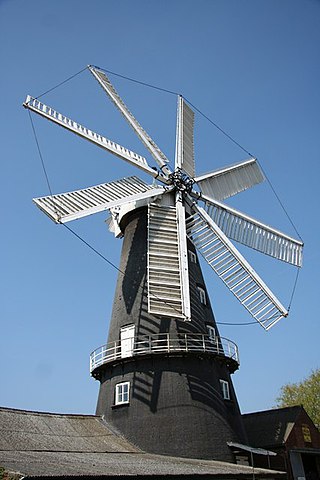
Heckington Windmill is the only eight-sailed tower windmill still standing in the United Kingdom with its sails intact.
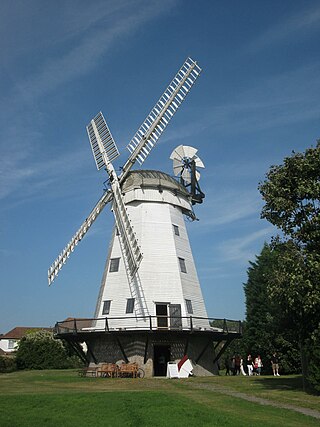
Upminster Windmill is a Grade II* listed smock mill located in Upminster in the London Borough of Havering, England. It was formerly known as Abraham's Mill and was in Essex when built. It has been restored and is a museum open to the public at selected times.

Maud Foster Windmill is a seven-storey, five sail windmill located by the Maud Foster Drain in Skirbeck, Boston, Lincolnshire, from which she is named. She is one of the largest operating windmills in England being 80 feet (24.38 m) tall to the cap ball.
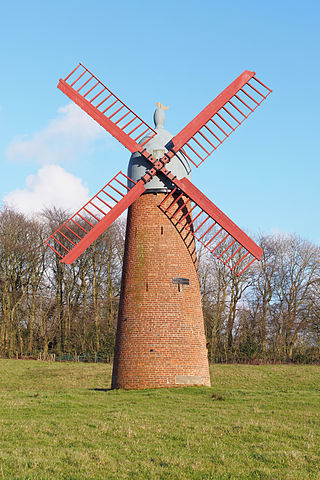
A tower mill is a type of vertical windmill consisting of a brick or stone tower, on which sits a wooden 'cap' or roof, which can rotate to bring the sails into the wind.

Metheringham Windmill, locally known as The Old Meg Flour Mill, was a six-storeyed, six-sailed, and tarred slender Lincolnshire type windmill with the typical white onion-shaped cap with fantail, built in 1867 to be used to grind flour from grain. Located on a paddock at the eponymous village in North Kesteven south of Lincoln it is one of the many tall brick-tower mills of Lincolnshire with stage, now disused.

Billingford Windmill is a grade II* listed brick tower mill at Billingford near Diss, Norfolk, England which has been preserved and restored to working order. As of June 2009, the mill is under repair, with new sails being made.

Burnham Overy Staithe Windmill is a Grade II* listed building tower mill at Burnham Overy Staithe, Norfolk, England which has been converted to holiday accommodation.

Caston Tower Windmill is a grade II* listed tower mill at Caston, Norfolk, England which is under restoration. The mill is also a scheduled monument.

Cley Windmill is a Grade II* listed tower mill at Cley next the Sea, Norfolk, England which has been converted to residential accommodation.

Ovenden's Mill or Mockett's Mill is a grade II* listed tower mill at Polegate, East Sussex, England which has been restored and is open to the public.

Shiremark Mill, also known as Kingsfold Mill or Capel Mill was a listed Smock mill at Capel, Surrey, England, which was burnt down in 1972.

South Ockendon Windmill was a Smock mill at South Ockendon, Essex, England which collapsed on 2 November 1977.

Thelnetham Windmill, also known as Button's Mill is a Grade II* listed tower mill constructed of brick. The windmill is located at Thelnetham, Suffolk, England. It was built in the early nineteenth century to grind wheat into flour. Thelnetham windmill worked by wind power until 1924, latterly on two sails, after which it became derelict.
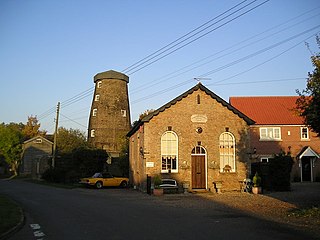
Buxhall Mill is a tower mill at Buxhall, Suffolk, England which has been converted to residential accommodation.

Holgate Windmill is a tower mill at Holgate in York, North Yorkshire, England which has been restored to working order.
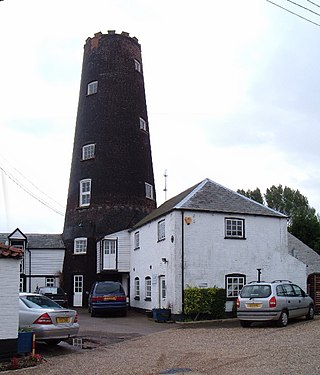
For the Gayton Windmill now in Merseyside see Gayton Windmill, Cheshire

De Wieker Meule is a smock mill in De Wijk, Netherlands. It was built in 1829 and has been restored to working order. The mill is listed as a Rijksmonument, number 39657.

Subscription Mill is a commercially working tower mill at North Leverton, Nottinghamshire that was built in 1813.
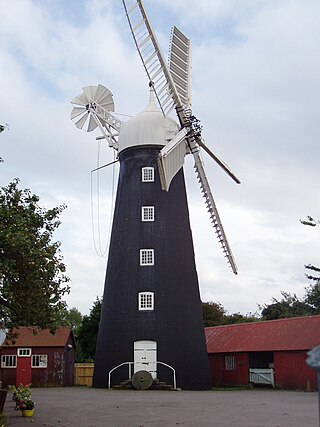
Dobson's Mill was a working tower windmill for grinding wheat and corn. It stands in the High Street in the town of Burgh le Marsh, near Skegness in Lincolnshire, England. The mill was, prior to damage by Storm Ciara on 9 February 2020, open to the public as a tourist attraction and is a Grade I listed building. The mill site also houses the Burgh-le-Marsh Heritage Centre.























